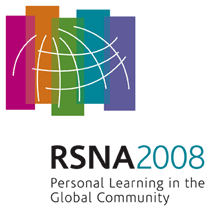
Abstract Archives of the RSNA, 2008
LL-BR2173-H01
Ultrasound and Core-needle Axillary Biopsy in Patients with Probably Malignant Breast Lesions
Scientific Posters
Presented on December 2, 2008
Presented as part of LL-BR-H: Breast Imaging
María José García Ortega MD, Presenter: Nothing to Disclose
Álvarez Benito Marina MD, Abstract Co-Author: Nothing to Disclose
Helena Fuentes Vaamonde Dipl Phys, Abstract Co-Author: Nothing to Disclose
Pablo Contreras Puertas DPhil, Abstract Co-Author: Nothing to Disclose
Julia Camps Herrero Dipl Phys, Abstract Co-Author: Nothing to Disclose
Jose Luis Raya Povedano Dipl Phys, Abstract Co-Author: Nothing to Disclose
To assess the diagnostic accuracy of axillary percutaneous core needle biopsy (CNB) in patients with probably malignant breast lesions. To evaluate its impact on patient management.
From October 2006 to July 2007, 257 patients with 261 probably malignant lesions and pathological confirmation were evaluated retrospectively. Bilateral axillary ultrasound (US) was performed in all patients and 14-Gauge CNB in those patients with dominant or suspicious lymph nodes.
Patients with a malignant result in CNB were excluded from the sentinel node procedure (SLNP) and treated with surgery or neoadjuvant chemotherapy depending on the size of the primary tumor.
Patients with a benign result in CNB were treated with surgery and SLNP or axillary dissection (AD) depending on the size and extent of the tumor. Almost all patients treated with mastectomy were subsequently treated with immediate breast reconstruction surgery. Results obtained with US and axillary CNB were correlated with those obtained with SLNB and/or AD.
113 CNB were performed in 257 patients with the following results: negative in 63 patients, breast cancer metastases in 45 patients, lymphoma in 1 patient and metastases from other primaries in 4 patients. The therapeutic approach in patients with a positive result was: neoadjuvant chemotherapy in 15 patients, specific treatment depending on the primary tumor in 5 patients, unkown in one patient and surgery with AD in 29 patients (20 mastectomies and 9 tumorectomies). In 44 patients with a negative (benign) result in CNB, SLNP was performed, as well as 28 tumorectomies, 13 mastectomies with immediate reconstruction and 3 mastectomies without reconstructive surgery. Diagnostic accuracy of axillary US: sensitivity 63%, specificity 86%, positive and negative predictive values 75% and 78%. Diagnostic accuracy of CNB: sensitivity 73%, specificity 100%, positive and negative predictive values 100% and 77% respectively.
US evaluation followed by CNB allow for a more precise therapeutic approach in breast cancer patients. In our series, 37% of the patients have been spared from the SLNP and 60% of the patients treated with mastectomy and negative CNB have been treated with immediate breast reconstruction.
Preoperative axillary US and CNB permits a better selection of patients for the SLNP, optimizing medical resources.
García Ortega, M,
Marina, &,
Fuentes Vaamonde, H,
Contreras Puertas, P,
Camps Herrero, J,
Raya Povedano, J,
Ultrasound and Core-needle Axillary Biopsy in Patients with Probably Malignant Breast Lesions. Radiological Society of North America 2008 Scientific Assembly and Annual Meeting, February 18 - February 20, 2008 ,Chicago IL.
http://archive.rsna.org/2008/6008943.html

